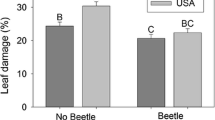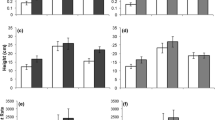Abstract
Herbivory can reduce plant fitness, and its effects can be increased by competition. Though numerous studies have examined the joint effects of herbivores and competitors on plant performance, these interactive effects are seldom considered in the context of plant invasions. Here, we examined variation in plant performance within a competitive environment in response to both specialist and generalist herbivores using Chinese tallow as a model species. We combined tallow plants from native and invasive populations to form all possible pairwise combinations, and designated invasive populations as stronger neighbours and native populations as weaker neighbours. We found that when no herbivory was imposed, invasive populations always had higher total biomass than natives, regardless of their neighbours, which is consistent with our assumption of increased competitive ability. Defoliation by either generalist or specialist herbivores suppressed plant growth but the effects of specialists were generally stronger for invasive populations. Invasive populations had their lowest biomass when fed upon by specialists while simultaneously competing with stronger neighbours. The root/shoot ratios of invasive populations were lower than those of native populations under almost all conditions, and invasive plants were taller than native plants overall, especially when herbivores were present, suggesting that invasive populations may adopt an “aboveground first” strategy to cope with herbivory and competition. These results suggest that release from herbivores, especially specialists, improves an invader’s performance and helps to increase its competitive ability. Therefore, increasing interspecific competition intensity by planting a stronger neighbour while simultaneously releasing a specialist herbivore may be an especially effective method of managing invasive plants.


Similar content being viewed by others
References
Battaglia LL, Denslow JS, Inczauskis JR, Baer SG (2009) Effects of native vegetation on invasion success of Chinese tallow in a floating marsh ecosystem. J Ecol 97:239–246
Blossey B, Nötzold R (1995) Evolution of increased competitive ability in invasive nonindigenous plants: a hypothesis. J Ecol 83:887–889
Boggs CL (1997) Resource allocation in variable environments: comparing insects and plants. In: Bazzaz FA, Grace J (eds) Plant resource allocation. Academic, New York, pp 73–92
Bossdorf O, Prati D, Auge H, Schmid B (2004) Reduced competitive ability in an invasive plant. Ecol Lett 7:346–353
Bossdorf O, Auge H, Lafuma L, Rogers W, Siemann E, Prati D (2005) Phenotypic and genetic differentiation between native and introduced plant populations. Oecologia 144:1–11
Bruce KA, Cameron GN, Harcombe PA, Jubinsky G (1997) Introduction, impact on native habitats, and management of a woody invader, the Chinese tallow tree, Sapium sebiferum (L) Roxb. Nat Areas J 17:255–260
Chun YJ, van Kleunen M, Dawson W (2010) The role of enemy release, tolerance and resistance in plant invasions: linking damage to performance. Ecol Lett 13:937–946
Colautti RI, Ricciardi A, Grigorovich IA, MacIsaac HJ (2004) Is invasion success explained by the enemy release hypothesis? Ecol Lett 7:721–733
Crawley MJ (1997) Plant–herbivore dynamics. In: Crawley MJ (ed) Plant ecology. Blackwell, Oxford, pp 401–474
DeWalt SJ, Siemann E, Rogers WE (2006) Microsatellite markers for an invasive tetraploid tree, Chinese tallow (Triadica sebifera). Mol Ecol Notes 6:505–507
DeWalt SJ, Siemann E, Rogers WE (2011) Geographic distribution of genetic variation among native and introduced populations of Chinese tallow tree, Triadica sebifera (Euphorbiaceae). Am J Bot 98:1128–1138
Elton CS (1958) The ecology of invasions by animals and plants. Methuen, London
Fornoni J (2011) Ecological and evolutionary implications of plant tolerance to herbivory. Funct Ecol 25:399–407
Fornoni J, Núñez-Farfán J, Valverde PL, Rausher MD (2004) Evolution of mixed strategies of plant defense allocation against natural enemies. Evolution 58:1685–1695
Freckleton RP (2000) Biological control as a learning process. Trends Ecol Evol 15:263–264
Goldberg DE (1990) Components of resource competition in plant communities. In: Grace JB, Tilman D (eds) Perspectives on plant competition. Academic, New York, pp 27–49
Goldberg DE, Novoplansky A (1997) On the relative importance of competition in unproductive environments. J Ecol 85:409–418
Haag JJ, Coupe MD, Cahill JF (2004) Antagonistic interactions between competition and insect herbivory on plant growth. J Ecol 92:156–167
Hambäck PA, Beckerman AP (2003) Herbivory and plant resource competition: a review of two interacting interactions. Oikos 101:26–37
Huang W, Siemann E, Wheeler GS, Zou J, Carrillo J, Ding J (2010) Resource allocation to defence and growth are driven by different responses to generalist and specialist herbivory in an invasive plant. J Ecol 98:1157–1167
Jones RH, McLeod KW (1990) Growth and photosynthetic responses to a range of light environments in Chinese tallow tree and Carolina ash seedlings. For Sci 36:851–862
Julien MH, Kerr JD, Chan RR (1984) Biological control of weeds: an evaluation. Prot Ecol 7:3–25
Karban R, Strauss SY (1993) Effects of herbivores on growth and reproduction of their perennial host, Erigeron glaucus. Ecology 74:39–46
Keane RM, Crawley MJ (2002) Exotic plant invasions and the enemy release hypothesis. Trends Ecol Evol 17:164–170
Lambers H, Chapin FSI, Pons TL (2008) Plant physiological ecology, 2nd edn. Springer, New York
Lammers JW, Stigter H (2004) Pest risk analysis—Cnidocampa flavescens. Plant Protection Service, Wageningen
Lankau RA (2007) Specialist and generalist herbivores exert opposing selection on a chemical defense. New Phytol 175:176–184
Levine JM, Adler PB, Yelenik SG (2004) A meta-analysis of biotic resistance to exotic plant invasions. Ecol Lett 7:975–989
Maron JL, Crone E (2006) Herbivory: effects on plant abundance, distribution and population growth. P R Soc B 273:2575–2584
Maron JL, Vilà M (2001) When do herbivores affect plant invasion? Evidence for the natural enemies and biotic resistance hypotheses. Oikos 95:361–373
McFadyen REC (1998) Biological control of weeds. Annu Rev Entomol 43:369–393
McNaughton SJ (1983) Compensatory plant growth as a response to herbivores. Oikos 40:329–336
Mitchell CE, Agrawal AA, Bever JD, Gilbert GS, Hufbauer RA, Klironomos JN, Maron JL, Morris WF, Parker IM, Power AG, Seabloom EW, Torchin ME, Vazquez DP (2006) Biotic interactions and plant invasions. Ecol Lett 9:726–740
Müller-Schärer H, Schaffner U, Steinger T (2004) Evolution in invasive plants: implications for biological control. Trends Ecol Evol 19:417–422
Pattison RR, Mack RN (2008) Potential distribution of the invasive tree Triadica sebifera (Euphorbiaceae) in the United States: evaluating CLIMEX predictions with field trials. Glob Change Biol 14:813–826
Pilson D (2000) The evolution of plant response to herbivory: simultaneously considering resistance and tolerance in Brassica rapa. Evol Ecol 14:457–489
Reader RJ (1992) Herbivory, competition, plant mortality and reproduction on a topographic gradient in an abandoned pasture. Oikos 65:414–418
Rogers WE, Siemann E (2004) Invasive ecotypes tolerate herbivory more effectively than native ecotypes of the Chinese tallow tree Sapium sebiferum. J Appl Ecol 41:561–570
Rogers WE, Siemann E (2005) Herbivory tolerance and compensatory differences in native and invasive ecotypes of Chinese tallow tree (Sapium sebiferum). Plant Ecol 181:57–68
Schädler M, Brandl R, Haase J (2007) Antagonistic interactions between plant competition and insect herbivory. Ecology 88:1490–1498
Schmid B, Bazzaz FA (1987) Clonal integration and population structure in perennials: effects of severing rhizome connections. Ecology 68:2016–2022
Siemann E, Rogers WE (2003a) Increased competitive ability of an invasive tree may be limited by an invasive beetle. Ecol Appl 13:1503–1507
Siemann E, Rogers WE (2003b) Herbivory, disease, recruitment limitation, and success of alien and native tree species. Ecology 84:1489–1505
Strauss SY, Agrawal AA (1999) The ecology and evolution of plant tolerance to herbivory. Trends Ecol Evol 14:179–185
Strauss SY, Zangrel AR (2002) Plant–insect interactions in terrestrial ecosystems. In: Herrera CM, Pellmyr O (eds) Plant–animal interactions. An evolutionary approach. Blackwell, Malden, pp 77–106
Suwa T, Louda SM, Russell FL (2010) No interaction between competition and herbivory in limiting introduced Cirsium vulgare rosette growth and reproduction. Oecologia 162:91–102
Tilman D (1982) Resource competition and community structure. Princeton University Press, Princeton
Tilman D (1994) Competition and biodiversity in spatially structured habitats. Ecology 75:2–16
Vilà M, Weiner J (2004) Are invasive plant species better competitors than native plant species? Evidence from pair-wise experiments. Oikos 105:229–238
Wang Y, Huang W, Siemann E, Zou J, Wheeler GS, Carrillo J, Ding J (2011) Lower resistance and higher tolerance of host plants: biocontrol agents reach high densities but exert weak control. Ecol Appl 21:729–738
Zhang KD, Lin YT (1994) Chinese tallow. China Forestry Press, Beijing
Zou JW, Rogers WE, DeWalt SJ, Siemann E (2006) The effect of Chinese tallow tree (Sapium sebiferum) ecotype on soil–plant system carbon and nitrogen processes. Oecologia 150:272–281
Zou JW, Rogers WE, Siemann E (2008a) Increased competitive ability and herbivory tolerance in the invasive plant Sapium sebiferum. Biol Invasions 10:291–302
Zou JW, Siemann E, Rogers WE, DeWalt SJ (2008b) Decreased resistance and increased tolerance to native herbivores of the invasive plant Sapium sebiferum. Ecography 31:663–671
Acknowledgments
We thank Hongjun Dai, Yi Wang and Shunliang Feng for their field assistance. We thank several anonymous reviewers and Jacqui Shykoff for their comments that improved an earlier version of this manuscript. This study was supported by the 100 Talent Program of the Chinese Academy of Sciences (to J.D.), the US National Science Foundation (DEB 0820560 to E.S.), an NSF pre-doctoral fellowship (to J.C.), and a foreign visiting professorship from the Chinese Academy of Sciences (to E.S.).
Author information
Authors and Affiliations
Corresponding author
Additional information
Communicated by Jacqui Shykoff.
Rights and permissions
About this article
Cite this article
Huang, W., Carrillo, J., Ding, J. et al. Interactive effects of herbivory and competition intensity determine invasive plant performance. Oecologia 170, 373–382 (2012). https://doi.org/10.1007/s00442-012-2328-6
Received:
Accepted:
Published:
Issue Date:
DOI: https://doi.org/10.1007/s00442-012-2328-6




